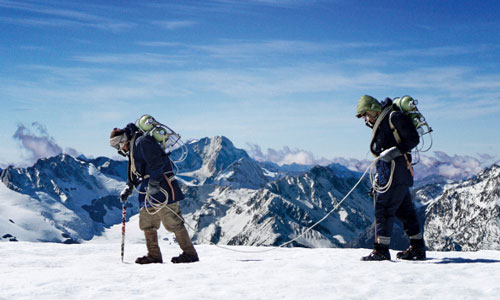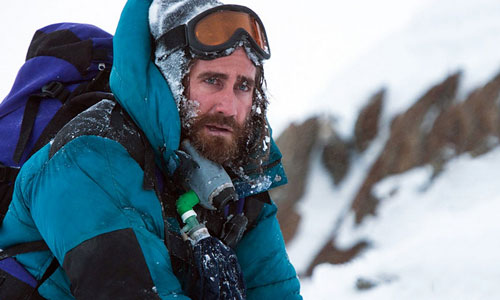Inspired by the tragic events surrounding an attempt in 1996, Everest documents the real-life ordeal suffered on 10 May, 1996, when Rob Hall, the safety-conscious and meticulous leader of New Zealand-based Adventure Consultants, and Scott Fischer, the highly experienced mountaineer and team leader of the Seattle-based Mountain Madness, led their teams on a final ascent toward the highest point on Earth: the summit of Everest, 29,029 ft. (8,848m) above sea level - or the cruising altitude of a 747.
Everest is not a disaster film that solely relies on visual effects like San Andreas, Deep Impact, World War Z or Armageddon, where we were bombarded by a visual effects extravaganza and special effects, but a character-driven narrative in the tradition of Alive, Twister, and The Impossible, where we bond with the characters and are taken on an emotional journey.
It's a film about people and how they deal with life at its most challenging, and also a film showing how relentless and unpredictable Mother Nature can be. It's an ensemble piece and although they compete against the majestic Everest and breathtaking landscapes, there are intimate moments where they take us into the soul of their characters. The filmmakers make a point of showing us that life continues, no matter what happens, and that we are responsible for the choices we make in life.

It's not possible for everyone to climb Mount Everest, and the film succeeds in giving us an intimate glimpse into the lives of extremists who step outside their comfort zones to take on an ultimate challenge; it shows that bravery has a price and that, despite all, we remain human and that our mortality is a fleeting moment in the eye of the storm that rages on Mount Everest.
The art of film lies in suspending disbelief and drawing its audience into a fictional reality created by the filmmaker. Although Everest was filmed in locations as far afield as Nepal, the Italian Alps, Cinecittà Studios in Rome and Pinewood Studios in the UK, we fully immerse ourselves in the journey, thanks to the creative team.
Everest is a great example of how the visual, temporal and performance art of film merge to deliver a film that balances the aesthetic with the emotional, which is geared at those who seeks entertainment with meaning, and not just visual eye candy.
Most audiences are familiar with Mount Everest through documentaries, and director Baltasar Kormákur ensured to avoid the cinéma vérité feel. This style of documentary filmmaking, invented by Jean Rouch, inspired by Dziga Vertov's theory about Kino-Pravda and influenced by Robert Flaherty's films, is sometimes called observational cinema, which is understood as pure direct cinema, mainly without a narrator's voice-over where the camera is seen as the best way to reveal the truth in cinema.
With Everest, Kormákur never intrudes on the story - he wanted Everest be "authentically and cinematically shot so that the cast and crew, as well as the audience, would comprehend the immensity of the mountain and be emotionally invested in the stories of these actual people".

Film is foremost a visual art and the visual artistry of the Everest is magnificently realised by production designer Gary Freeman (whose credits as supervising art director include Kenneth Branagh's Cinderella, Carl Rinsch's 47 Ronin, and Tim Burton's Sweeney Todd: The Demon Barber of Fleet Street), cinematographer Salvatore Totino, (known for his work with director Ron Howard on Angels & Demons, Frost/Nixon, The Da Vinci Code, and Oliver Stone's Any Given Sunday), and Icelandic director Kormákur, who is renowned for films such as 101 Reykjavik, The Sea, A Little Trip to Heaven, Jar City and White Night Wedding, and skilfully supervised the mechanics of filming.
Film is also a temporal art and, in Everest, director Kormákur's interpretation of the screenplay by William Nicholson (who co-wrote Gladiator as well as Sarafina!, Elizabeth: The Golden Age, Les Misérables, and Mandela: Long Walk to Freedom), and Simon Beaufoy (who won an Oscar for Slumdog Millionaire), and his collaboration with film editor Mick Audsley (whose films Harry Potter and the Goblet of Fire; 12 Monkeys, and Interview With the Vampire: The Vampire Chronicles) allow us to crawl under the skin and into the mindscape of the characters.
The formidable ensemble cast deliver heartfelt and passionate performances, led by Jason Clarke (Zero Dark Thirty, Dawn of the Planet of the Apes) as Rob Hall, head of Adventure Consultants and expedition leader; Josh Brolin (No Country for Old Men, True Grit) as Beck Weathers, a Texas pathologist with his sights set on summiting Everest; John Hawkes (The Sessions, Winter's Bone) as Doug Hansen, a postman and adventure enthusiast who failed to summit the previous year; Michael Kelly (Changeling) as Jon Krakauer, a journalist from Outside magazine embedded with Hall's team; Sam Worthington (Wrath of the Titans) as Guy Cotter, a fellow guide and close friend of Hall who refuses to give up hope; Emily Watson (War Horse) as the heart of Adventure Consultants, who serves as its logistics coordinator and Base Camp manager; and Jake Gyllenhaal (Nightcrawler, Southpaw) as Scott Fischer, expedition leader for Mountain Madness.
If you really want to experience Everest at its most captivating and intriguing, make sure to see it in IMAX 3D for maximum involvement.
When he was first asked to read Everest, director Baltasar Kormákur's reaction was pure excitement. "Landscape and weather is at least the half of me," he provides. "In Iceland, nature is never far away. Volcanos erupting and avalanches taking out villages on a regular basis remind you of Mother Nature's might. Having travelled on horses through the highlands of Iceland for weeks and no civilisation in sight, I always wanted to tell a story of people faced with the extremes of nature and that way reveal their characters in a subtle way - learning more and more who they are as they get deeper in. In my experience, you will never learn to know your friends better than in such conditions - what they are made of- especially when it gets real. So being offered to tell a unique story on the world's tallest mountain was a once-in-a-lifetime opportunity that I could not shy away from."
Kormákur admits that this opportunity appealed to him on a profound level: "I wanted to make it in the most authentic way possible. To take people on a journey up Everest and show them the mountain in a way that hasn't been possible until now - and at the same time create intimacy between the characters that is all too rare in big studio films."
The filmmaker was fascinated by the many who've attempted the climb, interested in the glory of the experience or desire to achieve a lifelong goal. He reflects: "You might ask, 'Why do you need to climb Everest?' and nobody can really answer that. But you might also ask: 'Why do you need to live life? Why do you need to have a career?' Even people who have a lot of money, they still need to have careers. So it's one of these questions that is hard to answer."
Kormákur's research and preparation for what he describes as "the hardest thing I've done in my life" began in earnest with his reading every book and document about the events that he could get his hands on. He had countless conversations with people who had climbed Everest, trying to understand the mindset of a climber. He took a trip to Everest early in preproduction, then travelled to New Zealand to meet the families of those involved.
Working Title producer Tim Bevan first became interested in the story when he read Jon Krakauer's Into Thin Air soon after it was published in 1997. Krakauer, a journalist who had been part of Rob Hall's Adventure Consultants team on the mountain that May, had first documented the events for an article in Outside magazine. Bevan's producing partner, Eric Fellner, shared his enthusiasm for the project; they discovered that Universal Pictures, with which Working Title has a long-term distribution agreement, coincidentally owned other properties relating to the events. These included Beck Weathers' Left for Dead: My Journey Home from Everest, from which the film draws inspiration, as well as the transcript of the final satellite phone conversation between Rob Hall and his wife, Jan Arnold. While the families of the climbers involved had remained mostly quiet about the tragic events over the years, they maintained an ongoing dialogue with the filmmakers, working toward an appropriate time for a feature-film reimagining of the events to be made.
Reflects Bevan: "To start with, we reached out to David Breashears, who had been on the mountain in 1996 and shot the seminal Imax film about Everest. I discovered that he definitely had the best documents relating to it. It's one of those stories, because there's something so gripping about it - and the fact that so many people either have written or spoken accounts about what had happened up there - that it's a bit like a Rubik's Cube: every way you jangle it, there's another permutation that pops up. It was in danger of becoming one of those stories that would never be told because of that fact, but it was truly a passion project for Working Title."
Says Kormákur: "I wanted to make it in the most authentic way possible. To take people on a journey up Everest and show them the mountain in a way that hasn't been possible until now - and at the same time create intimacy between the characters that is all too rare in big studio films."
For him, this story is both one of achievement and a cautionary tale. "Everest is a metaphor for any kind of ambition, and anyone who has ambition needs to balance that with his family life. There's the mountain and there's home, and the distance between the two is immense, pulling in two opposite directions."
